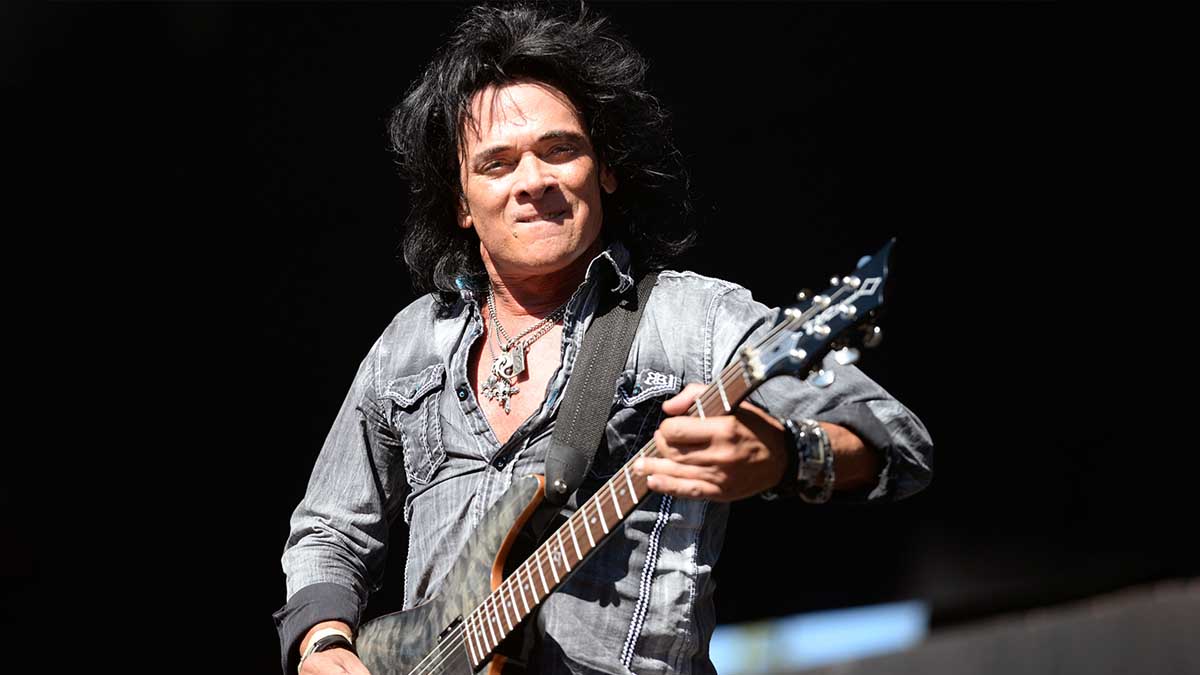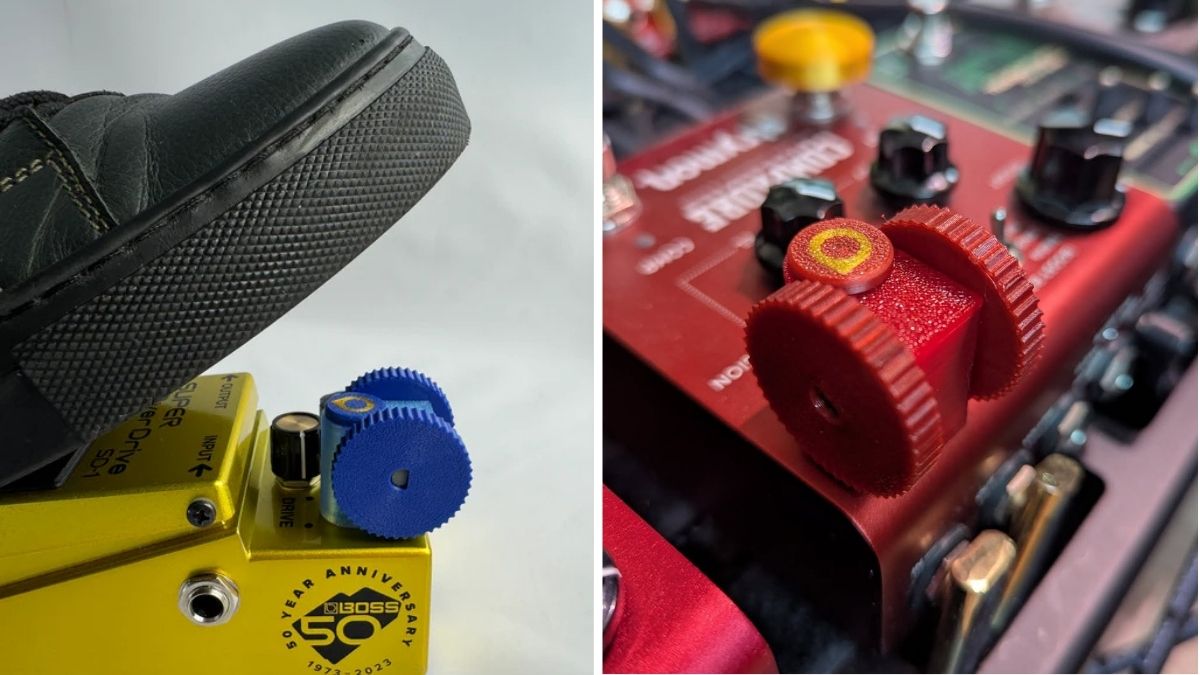“I was aggressively informed, ‘That’s Eddie’s technique. You’re not allowed to play it on the tour – or else’”: Former Autograph guitar maestro Steve Lynch on theory, technique, and life as a tapping pioneer
Lynch was a trailblazer for two-handed tapping, but when his band opened for Van Halen, Lynch was prohibited by Van Halen's management from using his trademark technique (a ban that was later lifted at the behest of Eddie himself)

By the time Steve Lynch burst onto the scene with Autograph, he was nearly 30 – a relative dinosaur compared to some of the young bucks he was up against. But no matter, Lynch’s style – which includes a dizzying array of arpeggios, triads, and intervals – stood out from the pack.
Lynch was so slick that by the time Autograph’s 1984 banger, Sign In Please, was released, his greatest foe was Eddie Van Halen, who happened to be Lynch’s brother in two-handed tapping heroics.
“When our tour with Van Halen started, I was asked by their management, ‘Are you Steve Lynch, the one who wrote The Right Touch’ [A 1982 instructional book with the full title The Right Touch: The Art of Hammering Notes with the Right Hand]? I said, ‘Yes, I am,’” Lynch says. “I was then aggressively informed, ‘That’s Eddie’s technique; you’re not allowed to play it on the tour – or else.’ I was pissed that I couldn’t play something I had created.
“So, later on, I confronted Eddie about it, to which he replied, ‘I had no idea they put those restrictions on you. I’ll call the dogs off.’ I graciously thanked him and played whatever I wanted for the rest of the tour. I’ll never know if he was telling the truth, but I don’t care; we hit it off well after that.”
While Autograph’s time in the limelight was short, their influence remains. Sure, they couldn’t duplicate the breakneck success Turn Up the Radio, but that hasn’t stopped Lynch from making it known that – greatest hits aside – Autograph mattered.
“We’d played in other bands before our Sunset Strip days, but Autograph were different,” Lynch says. “We went from guys playing and rehearsing together for fun to opening for Van Halen. Suddenly we were driving across the U.S. in a dilapidated Winnebago to play in front of an 18,000-seat sold-out venue opening for the biggest band in the world, and we didn’t even have a name yet.
“On that treacherous journey, we devised a name we could use... Autograph. Then RCA signed us to a three-album deal backstage at Madison Square Garden... who would have thought? Measuring our importance is hard, but we earned the right to be there.”
All the latest guitar news, interviews, lessons, reviews, deals and more, direct to your inbox!
My style evolved when I stopped listening to other guitarists and started listening to jazz
Taking some time away from his ongoing solo work and potential plans for an Autograph reunion, Steve Lynch dialed in with GW to discuss his approach to the guitar, the recording of his finest solos, and more.
Describe the early evolution of your style.
“The spark was lit when the Beatles played on Ed Sullivan’s show in 1964. My older sister had some of her cute girlfriends over to watch, and when I saw their reaction to the performance, I thought, ‘That’s what I want to do!’ And that’s when I received an acoustic made of particle board from the Sears & Roebuck catalog, with strings so high off the neck you had to stand on them to make a note come out.
“My style evolved when I stopped listening to other guitarists and started listening to jazz, which guided me in an obscure direction. But when Autograph formed, I had to abandon my progressive side for a more commercially accepted style. It didn’t bother me much, though... I had to pay the rent somehow [Laughs].”
What are the origins of your two-hand tapping technique?
“I first saw Harvey Mandel playing around with it at a soundcheck at a club in downtown Seattle in the early Seventies. That’s what first inspired me. Then I saw a local guy named Steve Buffington experimenting with it, which made me pursue it more. But Emmett Chapman, the inventor of the Stick, made me immerse myself in it.
“He did a clinic at GIT [Guitar Institute of Technology, now the Musicians Institute], and I was awestruck by the sounds he created. I immediately began to train my hand and began writing the two-hand theory, including arpeggios, triads, chord inversions, scales, intervals, and double-stops.”
I would have never been able to create the solos I did without my theory knowledge
Did being well-versed in music theory aid in crafting solos?
“I would have never been able to create the solos I did without my theory knowledge. But I didn’t necessarily think about theory when creating them; it just happened. I’ve never created a solo with a guitar in my hands.
“I would have the band play a couple of bars with vocals before the solo, then play through the solo section, and then come back in with a couple of bars after the solo with vocals, all while I recorded it. Then I’d take that recording home and listen to it until I heard the solo unfold in my mind. I’d then built the solo part by part until I felt it was complete.”
It took me five eight-hour days to create that solo. Whenever I thought I had it, I’d listen to it the next day and think it sucked
Can you recount the recording of your Turn Up the Radio solo?
“It took me five eight-hour days to create that solo. Whenever I thought I had it, I’d listen to it the next day and think it sucked. I knew the song could be a hit, so I wanted the perfect solo. At the end of that fifth day, I listened to the recording I’d done at home and realized I had it.
“I went into the studio the next day and laid it down. I played my custom-made Charvel through a mid-Sixties Marshall head and 4x12 cab with a little delay and reverb from the outboard gear. I doubled the solo, as I always do.
“On the first track, we ran the Studer two-inch analog machine at 101 percent speed to be slightly below pitch when played back at normal speed. We recorded at 99 percent on the second track, so it was slightly above pitch when played back. This gave the illusion there was a phaser or flanger applied.”
What combination of guitar amps, pedals and guitars are you using now?
“I’m not touring now, so I’m not using any particular amps, just my Headrush and Roland GR-55 guitar synth for recording. But I’m also looking into the latest version of Guitar Rig and AmpliTube for my home recordings. At the moment, I’m way too busy to tour, but that may very well change soon.
“My favorite guitars are the ones I had custom-made by Dale Roberts from his shop in Jacksonville, Florida. They are perfect for my hands and sound the best for the two-handed technique, which requires a lot of output and sustain. I also use my Strats, Les Pauls and whatever others I have lying around.”
One slice of advice is to release singles one at a time and do your best on the writing, performance, arrangement, and production for each
Is it a challenge to create new music for a low-attention-span world?
“There are no obstacles, with the internet and social media, to promote your material worldwide and the convenience of recording from your home. You don’t need a record contract – you can write and record with anyone at any time, anywhere.
“One slice of advice is to release singles one at a time and do your best on the writing, performance, arrangement, and production for each. If you wish to complete a full collection of songs, that’s fine, but most people never listen to the whole album.”
Do you feel beholden to your past?
“I don’t feel obligated to do anything I’ve previously done because I’ve evolved musically. The past doesn’t define who I am – I’m very grateful for the success I’ve had with Autograph and will always cherish those memories... and may again someday, but I’m just not reliant on it. Most musicians who genuinely love their craft feel the same. I’m completely comfortable where I am now because I think new adventures await everywhere.”
What’s next for you?
“I’m still writing for my project, Blue Neptune, which will be a solo effort. I see it as a modern-day The Dark Side of the Moon, my favorite album. It will be singles. And there’s potential for me to revisit a reformed Autograph. I never rule that out. But it would not be with the current lineup who are performing as ‘Autograph.’ It would be a fresh start with new personnel with a different perspective. Only time will tell.
“Other than that, I’m just a kid who, against all odds, dug out a name from the rubble. I am incredibly grateful for it, but I’m still that kid from Seattle who went to L.A. to follow a dream and found it.”
- Follow Steve Lynch on Instagram.
Andrew Daly is an iced-coffee-addicted, oddball Telecaster-playing, alfredo pasta-loving journalist from Long Island, NY, who, in addition to being a contributing writer for Guitar World, scribes for Bass Player, Guitar Player, Guitarist, and MusicRadar. Andrew has interviewed favorites like Ace Frehley, Johnny Marr, Vito Bratta, Bruce Kulick, Joe Perry, Brad Whitford, Tom Morello, Rich Robinson, and Paul Stanley, while his all-time favorite (rhythm player), Keith Richards, continues to elude him.



